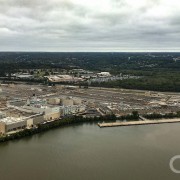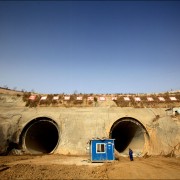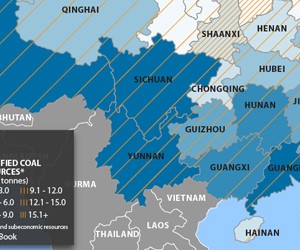Australia Builds Desalination Plants and Pipelines to Bring Water to Mines
To feed water-hungry mining industries, similar plans are in the works to supply drought-ridden regions of Australia and China.
As is the case in China, Australia—one of the world’s largest coal, copper, and uranium producers—suffers from a geographical mismatch of water resources and mineral deposits.
In the nation’s relatively dry interior, mining and processing require more than 100,000 cubic meters (26 million gallons) of water each day. To increase output, mining companies will need more water than is locally available, but hydrological demands have already surpassed the supply limit in many areas.
Water recycling is widely employed—up to 80 percent of the mining water in the Bowen coal basin is re-used, according to University of Queensland professor Damian Barrett—but even these measures can’t overcome natural constraints.
To alleviate this chokepoint, there are plans for a multi-billion-dollar network of water infrastructure projects—a desalination plant, dams, and more than a thousand kilometers of pipelines, most of which will be approved this year—that will transport water from reservoirs, aquifers, and the ocean to mines in the states of South Australia,Western Australia, and Queensland, Australia’s leading coal producer.
Project: Connors River Dam and Nathan Dam
| Province | Targeted Completion | Company |
| Queensland | 2014 | Government-owned developer SunWater |
|
Along with their associated pipelines, these projects are at the state’s centerpiece. The mining industry is designated the highest priority use for water from both reservoirs. The 133-kilometer (86-mile) pipeline from Connors River will deliver 49.5 million cubic meters (13 billion gallons) per year to Bowen Basin, while the 260-kilometer (160-mile) Nathan Pipeline siphons 70.8 million cubic meters (18.7 billion gallons) per year to the Surat and Bowen basins. |
||
Project: Moranbah-Galilee Pipeline
| Province | Targeted Completion | Company |
| Queensland | 2014 | Government-owned SunWater |
|
The 270-kilometer pipeline—an extension of the 217-kilometer Burdekin-Moranbah Pipeline, completed in 2007—would move water west from the Bowen Basin into the Galilee Basin. The project is still being studied, but if approved, construction would begin next year. (A similar pipeline leading to nickel mines in Western Australia was completed three years ago.) |
||
Project: Olympic Dam
| Province | Targeted Completion | Company |
| South Australia | Completed 11 years after expansion is approved | BHP Billiton, the world’s largest mining company |
|
The most ambitious mining-water supply project, which includes the expansion of the associated mine—it will become the world’s largest uranium producer and fourth-largest copper producer, in addition to gold and silver production. But the expansion depends on a coastal desalination plant—much like the proposed Bohai Pipeline to supply northern China’s coal regions—at Point Lowly on southern Australia’s Spencer Gulf. Four pumping stations will move water through the 320-kilometer (200-mile) pipeline, providing nearly 90 percent of the 83 million cubic meters (22 billion gallons) of water the mine will use each year for ore processing and dust suppression, along with drinkingwater for residential areas near the site. |
||
Not only are Australia’s large-scale projects reminiscent of China’s massive water infrastructure projects, but China’s growth is also spurring them. Between 2008 and 2009, copper exports to China—Australia’s top trading partner—doubled and coal exports increased ten-fold, according to Australia’s trade statistics.
Read more: Bohai Sea Pipeline Could Open China’s Northern Coal Fields and A Dry and Anxious North Awaits China’s Giant, Unproven Water Transport Scheme
Brett writes about agriculture, energy, infrastructure, and the politics and economics of water in the United States. He also writes the Federal Water Tap, Circle of Blue’s weekly digest of U.S. government water news. He is the winner of two Society of Environmental Journalists reporting awards, one of the top honors in American environmental journalism: first place for explanatory reporting for a series on septic system pollution in the United States(2016) and third place for beat reporting in a small market (2014). He received the Sierra Club’s Distinguished Service Award in 2018. Brett lives in Seattle, where he hikes the mountains and bakes pies. Contact Brett Walton








Leave a Reply
Want to join the discussion?Feel free to contribute!